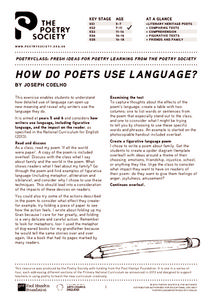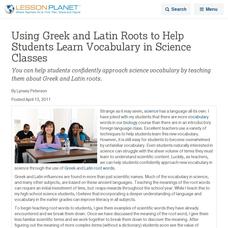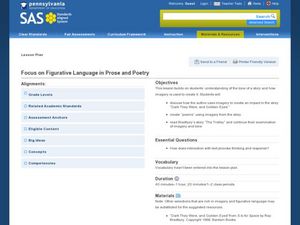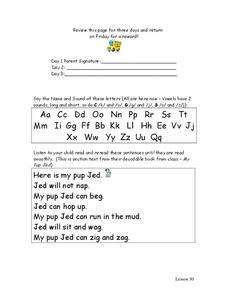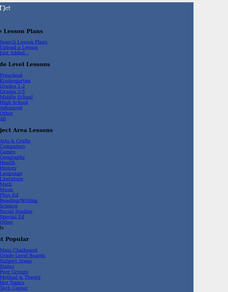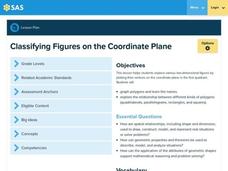Curated OER
Sentence Completion 5: High-intermediate Level
How do you figure out what word best completes a sentence? The answers and explanations key that accompanies an eight sentence exercise outlines the strategies used to determine the correct response for assessments of this type....
Poetry Society
How do Poets Use Language?
Why do writers choose the language they do? Here's a resource that has the poet himself answer that very question. Joseph Coelho explains why he chose the words and images he used in his poem, "If All the World Were Paper."
Curated OER
The Great Figure Questions
In this reading comprehension worksheet, students respond to 4 short answer and essay questions based on "The Great Figure'" by William Carlos Williams.
Curated OER
Using Greek and Latin Roots to Help Students Learn Vocabulary in Science Classes
You can help students confidently approach science vocabulary by teaching them about Greek and Latin roots.
Curated OER
Range, Mean, Median, Mode
Students research the impact of craters. In this range, mean, median and mode activity, students complete an experiment with a marble to simulate the effects of a crater. Students collect and analyze data finding the range, mean, median...
Curated OER
Focus on Figurative Language in Prose and Poetry
Students place emphasis on the use of figurative language when analyzing prose and poetry. In this figurative language lesson, students explore the tone of a story and its imagery. Students read and discuss how the author uses imagery in...
Curated OER
Review Letters and Words: 28
In this reviewing letters and words instructional activity, students read sentences, read word chunks, determine syllables, and more. Students complete 5 exercises.
Curated OER
Word and Letter Practice #6
In this word and letter practice worksheet, students say the name and sounds of given letters, read simple sentences, practice reading sight words and practice "chunks" of words.
Curated OER
Noisy Words 1-- Animal Noises
For this language arts worksheet, students explore onomatopoeia-- words that sound like what they mean. Students read 20 animal noises and write the name of the animal that makes each of the noises. Example: cock a doodle doo (rooster).
Curated OER
Analyzing Literary Devices
Eighth graders identify figurative language and poetry in this literary analysis lesson. Using Through the Looking Glass by Lewis Carroll and a YouTube video for "The Walrus and the Carpenter," young readers complete a literary device...
Florida Center for Reading Research
Vocabulary: Words in Context, Pun Fun
Scholars explore a variety of texts to locate wordplay. Partners read their selections and discuss meanings.
National Endowment for the Humanities
In Emily Dickinson's Own Words: Letters and Poems
Analyze the depth and beauty of American Literature by reading Emily Dickinson's letters and poems. The class analyzes Dickinson's poetic style and discusses Thomas Wentworth Higginson's editorial relationship with Dickinson. They pay...
Winterhill School
Poetry Analysis
Gain greater insight into poems using a poetry analysis learning exercise. Here, scholars follow steps and answer questions to dissect any poem. Topics include the poem's meaning, theme, technique, and structure, as well as personal...
Curated OER
Homophones: Fun with Puns
What is a homophone for aloud? Or right? Fifth graders complete a list of 24 homophones, choosing another word that sounds like a given word but has a different meaning. At the bottom of the page, they write punning sentences to practice...
Curated OER
Picturing Text
Students, through observation and discussion about the Coffin of Djed Mut, make connections between hieroglyphs and the English writing system. They create their own visual story using symbols that represent words.
EngageNY
Analyzing a Thematic Concept: The Invisibility of Captives during WWII (Pages 182-188)
Readers complete a word web-based on the word dignity. They use their Understanding Invisibility note catcher to discuss how dignity relates to the theme of invisibility. After group discussion comparing invisibility and loss of dignity,...
EngageNY
Analyzing Poems from Inside Out and Back Again to Develop Criteria for an Effective Poem
Scholars analyze a model poem to help guide their poetry writing. They use Think-Pair-Share to discuss word choice and meaning in "Papaya Tree" and "Wet and Crying." To finish, they use their discussions to collect evidence on what makes...
Curated OER
Hot, Hot, Hot, Cold
Learners dance the image of falling snow. They move, swing, fall, and rise to music working to depict snow falling, the sun, and high/low movements. This is a well-thought out lesson that aids them in seeing movement as a form of...
Curated OER
Reading Poetry
Present your class with an overview of poetry-related information. The slides are clearly organized by topic, starting with reading poetry, ending with myths, and touching on everything from the five senses to open and closed forms of...
Curated OER
My Antonia: Magic Squares (Vocabulary Strategy)
Help your pupils discover the power of context clues by teaching the this vocabulary strategy. Designed to go with words from Willa Cather's My Antonia, this exercise focuses on having individuals use their own words to define new...
Curated OER
Peter and the Starcatchers: Magic Squares
Engage your class in vocabulary from Peter and the Starcatchers with this exercise. Learners match words to their definitions to determine the magic number.
Curated OER
TAKS Quiz-Word Meaning
In this TAKS quiz learning exercise, students take an online quiz focused on word meaning similar to an underlined word. Quiz may be graded online by clicking a link.
Curated OER
Figurative Language Scavenger Hunt
Eighth graders analyze and interpret figurative language. They listen to some examples of poetry which use figurative language. Then, they divide into groups and attempt to find more examples. Finally, 8th graders write what the poet is...
Pennsylvania Department of Education
Classifying Figures on the Coordinate Plane
Fifth graders use estimation to solve word problems. In this fractions instructional activity, 5th graders decide whether or not an answer to a work problem is reasonable by applying their knowledge of fractions, decimals and estimation....



